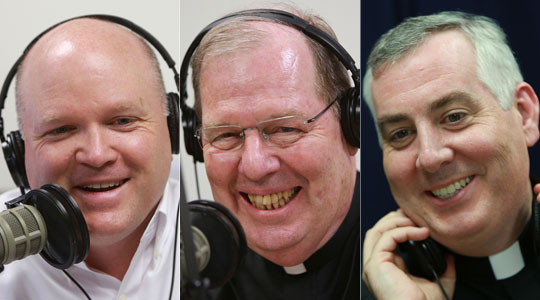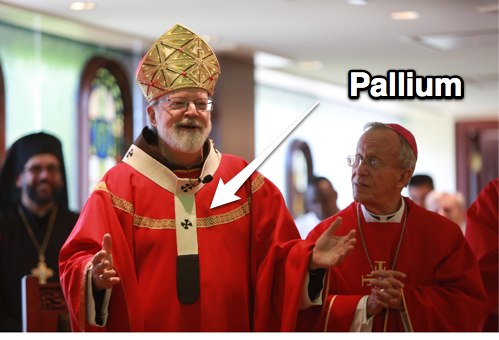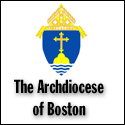Summary of today’s show: Earlier in June, Msgr. Robert Deeley and Msgr. William Fay traveled from Boston to Ugandan in Africa for the feast of St. Charles Lwanga and Companions, martyrs for the faith who are highly revered in that country. Scot Landry and Fr. Mark O’Connell talk with Msgr. Deeley about the trip, how it came about, the story of the martyrs, and the remarkable faith of the Ugandans today, where one parish has 100,000 people and a Mass will typically last three hours.
Listen to the show:
Podcast: Play in new window | Download
Today’s host(s): Scot Landry and Fr. Mark O’Connell
Today’s guest(s): Msgr. Robert Deeley, Vicar General of the Archdiocese of Boston
Links from today’s show:
Today’s topics: The Ugandan Martyrs and Catholicism in Uganda Today
1st segment: Scot welcomed Fr. Mark to the show and noted that the end of June marks the end of the fiscal year for the Archdiocese, which means goodbyes to people leaving and hellos to new people. Fr. Mark said they said goodbye to Sr. Peggy who was working as a judge in the Metropolitan Tribunal. Also, Mary Ryan, who worked in the finance department, is retiring after 20 years in service. Scot recalls that Mary was at the 8:15am Mass at the Pastoral Center every day. He said she worked in the Revolving Loan Fund, which functions like the Archdiocesan bank for parishes.
Fr. Tom Foley’s farewell Mass was yesterday. He leaves the post of Secretary for Parish Life and Leadership and is going to become an Air Force chaplain. Also, Bishop Arthur Kennedy is leaving as rector of St. John Seminary to take up a new office as vicar for the New Evangelization.
Also today, Scot asked listeners to pray for Cardinal Seán on his 68th birthday. He celebrated the noon Mass at the Pastoral Center and was joined representatives of the Orthodox Church to celebrate the feast of Saints Peter and Paul.
Today, Msgr. Robert Deeley is joining us to talk about a recent trip he took to Uganda to talk about the Ugandan martyrs.
2nd segment: Scot and Fr. Mark welcomed Msgr. Deeley to the show. Scot said June 29 makes him think of the feast of Sts. Peter and Paul and how it’s a big holiday in Rome. Msgr. Deeley spent many years in Rome and said it marks the two great apostles upon whom the Church was founded. It’s also traditional for the Pope to give the pallium, the symbol of the metropolitan archbishop’s office, to new archbishops from around the world. It reminds us of the unity of the Church and its expanse around the world. There were four Americans this year, three from the Roman rite: Archbishop Charles Chaput of Piladelphia; Archbishop Samuel Aquila of Denver; and Archbishop William Lori of Baltimore. They note that the Archbishop wears it only in his own diocese and the diocese’s of his province.
Moving to another topic, Msgr. Robert Deeley recently traveled to Uganda along with Msgr. William Fay at the beginning of June for the feast of the Ugandan martyrs. Msgr. Deeley went to Uganda because so many priests from Uganda come to Boston, especially to study at Boston College and other local colleges. While here, they live in our rectories and help out in our parishes. One Ugandan priest lived with Msgr. Fay for two years before returning to Uganda. Fr. Paul is rector of the cathedral in Lugazi, Uganda, and he invited Msgr. Fay and Msgr. Deeley to come and be there for the great feast of the Ugandan martyrs.
Msgr. Deeley said they didn’t go on safari so they saw no animals. It’s a beautiful country. They visited Lake Victoria and saw the source of the Nile, which travels 4,000 miles through Africa.
Scot said he was surprised that as little as 200 years ago there were practically no Christians in Uganda, but it was the martyrdom of St. Charles Lwanga and his companions in the 1880s led to the great growth of Catholicism. Msgr. Deeley said he wanted to go back a few steps. The king around 1850 wrote and asked Queen Victoria to send missionaries to impart values and morals they had. The first were Anglican and then Catholics followed. The king who succeeded the first about 6 or 7 years after the Catholic missionaries arrived was a selfish and immoral man. He murdered a group of young men who wouldn’t acquiesce to his immoral demands. The youngest of them was 13 or 14 years of age. Charles Lwanga was their leader. They were burned to death. There 13 Catholics and 11 Anglicans and shrines maintained by both Catholics and Anglicans are maintained at the site of the martyrdom.
The missionaries were expelled from Uganda, but the Catholic laity continue to teach and preach and catechize one another.
Scot said the king gave all the martyrs the chance to renounce their Christian faith, including a few who were only baptized at the last minute, but all chose to keep their faith even though they knew they would die in a horrible way.
At the time of the martyrdom, there were only about 200 Christians in the country and now there are millions, which shows how the blood of the martyrs become the seed and fertilizer for faith.
Msgr. Deeley said one of the eyewitnesses recalled how the martyrs pointed to the sky as they went to their death to signal that they were going to Paradise for their faith.
The celebration of this feast is a spectacular representation of the culture and faith and music and more. He said there were 1 million people at the celebration. Meanwhile, one of the bishops was here in Waltham to celebrate with a Ugandan community here as well as another in Germany doing likewise. Otherwise, every bishop in the country was there at the celebration. The Mass is celebrated on an artificial island in the middle of the lake and the people surround. People were singing in Swahili, Buganda, and Gregorian chant. The full representation of the whole Church, all ages, all vocations, was a spectacular view.
Fr. Mark asked for Msgr. Deeley’s experience. Msgr. Deeley said the Mass was five hours long, three hours for the Mass itself and two hours for the speeches at the end. This is the longest Mass he’d ever attended, including Easter vigil at St. Peter’s. The next day he went to the funeral of a local priest and that was three hours. People love to celebrate their faith and they do it with great joy and solemnity.
He said they were blessed because Maureen Heil of the Propagation of the Faith in Boston had contacted the head of the episcopal conference in Uganda who got excellent seats at the Mass on the island and they were announced as honored guests. Msgr. Deeley said the country is very poor and it’s still very young at only 50 years of independence. But their hospitality is tremendous.
Scot asked about the Church’s role in society in Uganda. Msgr. Deeley said in the cathedral parish they have 26 outstations or parishes in villages. They visited one parish where they met the pastor and his two associates. They had a parish school and a high school, built by people from Canada and the United States. He also had 30 more outstations with 12 schools and 100,000 people all in one parish.
They had tea with Bishop Matthias Ssekamaanya of Lugazi one night, and he told him that they believe that every parish needs a school and that as the outstations grow they will also become parishes with schools. The government funds some of the education. He said the vicar general of the diocese is also in charge of schools. The government’s funds are limited, and they also control what you can do. The government doesn’t allow the Church to take any fees whatsoever, including having children pay for lunches during the day in order to make it appear the education is completely free. There are also private schools, which aren’t run by the government or the Church.
Scot asked what Msgr. Deeley’s sense is of the freedom of the people to live their faith as Catholics, in light of the Fortnight for Freedom. He said the Church plays an important role as the voice of the poor, the needy and families. The country is 87% Christian, 13% Muslim; 40% Catholic, 30% Anglican. The Church is a very important force for the betterment of people and building of systems that are just and honest.
Fr. Mark asked how modern the area is. Msgr. Deeley said many buildings are indeed modern. They are building a new center for the episcopal conference, which the Archdiocese of Boston contributed to. He noted that they don’t use metal frameworks, but wood, and then add concrete and brick and the like. He said it’s a tropical climate so most places don’t have windows.
He said bananas are an important part of their diet, several different varieties they eat in many different ways.
Back to schools, he noted the dedication of teachers in the schools. They visited a school where one classroom had 75 students. They are trying their hardest to make education and opportunity available to the children of their communities. Many of the teachers are catechists. In each of the outstations, there is a catechist who is often a teacher or other professional. When they can’t have Mass with a priest, they gather for prayer and study. They try to get a priest to the outstations at least once per month.
Scot said there are several thousand Ugandans living just in Waltham. He asked how his experience helps Msgr. Deeley appreciate and welcome Catholics who come to our Archdiocese from all over the world. He said he saw how the faith is central to their lives. It’s not just something they do on Sunday, but their whole lives.
Scot said most people living in this area wouldn’t be able to say they personally someone who died for their faith, except perhaps people who’ve come here from other places around the world. He said he’s been moved by the stories from Vietnamese priests who tell of how the martyrdom of someone they knew inspired them.
Msgr. Deeley said he met a priest from Kenya who’d only been ordained a few days who was walking with his parish and they’d been walking 21 days to go to the shrine of the Martyrs. He told a story of being beaten and left by the side of a road because he’d been preaching about morality and faith. He only survived because another priest found him in time. The pilgrimage to the shrine was his way to thank God a year later. He was filled with joy and faith and was excited to go on this pilgrimage with the people of his parish.
Now as we do every week at this time, we will consider the Mass readings for this Sunday, specifically the Gospel reading.
God did not make death,
nor does he rejoice in the destruction of the living.
For he fashioned all things that they might have being;
and the creatures of the world are wholesome,
and there is not a destructive drug among them
nor any domain of the netherworld on earth,
for justice is undying.
For God formed man to be imperishable;
the image of his own nature he made him.
But by the envy of the devil, death entered the world,
and they who belong to his company experience it.
- Gospel for the 13th Sunday in Ordinary Time, July 1, 2012 (Mark 5:21–43)
When Jesus had crossed again in the boat
to the other side,
a large crowd gathered around him, and he stayed close to the sea.
One of the synagogue officials, named Jairus, came forward.
Seeing him he fell at his feet and pleaded earnestly with him, saying,
“My daughter is at the point of death.
Please, come lay your hands on her
that she may get well and live.”
He went off with him,
and a large crowd followed him and pressed upon him.There was a woman afflicted with hemorrhages for twelve years.
She had suffered greatly at the hands of many doctors
and had spent all that she had.
Yet she was not helped but only grew worse.
She had heard about Jesus and came up behind him in the crowd
and touched his cloak.
She said, “If I but touch his clothes, I shall be cured.”
Immediately her flow of blood dried up.
She felt in her body that she was healed of her affliction.
Jesus, aware at once that power had gone out from him,
turned around in the crowd and asked, “Who has touched my clothes?”
But his disciples said to Jesus,
“You see how the crowd is pressing upon you,
and yet you ask, ‘Who touched me?’”
And he looked around to see who had done it.
The woman, realizing what had happened to her,
approached in fear and trembling.
She fell down before Jesus and told him the whole truth.
He said to her, “Daughter, your faith has saved you.
Go in peace and be cured of your affliction.”While he was still speaking,
people from the synagogue official’s house arrived and said,
“Your daughter has died; why trouble the teacher any longer?”
Disregarding the message that was reported,
Jesus said to the synagogue official,
“Do not be afraid; just have faith.”
He did not allow anyone to accompany him inside
except Peter, James, and John, the brother of James.
When they arrived at the house of the synagogue official,
he caught sight of a commotion,
people weeping and wailing loudly.
So he went in and said to them,
“Why this commotion and weeping?
The child is not dead but asleep.”
And they ridiculed him.
Then he put them all out.
He took along the child’s father and mother
and those who were with him
and entered the room where the child was.
He took the child by the hand and said to her, “Talitha koum,”
which means, “Little girl, I say to you, arise!”
The girl, a child of twelve, arose immediately and walked around.
At that they were utterly astounded.
He gave strict orders that no one should know this
and said that she should be given something to eat.
Scot said he was struck by the long interruption in the story of Jairus and his daughter with the afflicted woman. The message was that our faith can heal us. Msgr. Deeley said it’s a good opportunity to remind us to avail ourselves of the opportunity to receive the Sacrament of the Anointing of the Sick before we go to the hospital. It is a healing sacrament. It can be difficult because of privacy laws to find out who is in the hospital and to visit them. He said it’s not Extreme Unction anymore and it’s not just the Last Rites.
Fr. Mark noted Jesus’ kindness, noticing the one woman in the crowd. He reached out to her with kindness and love. He also made sure the crowd knew the girl was not dead, but he told them she was just sleeping so people wouldn’t treat her like a zombie. St. Mark also puts in the Aramaic words that show Jesus’ gentleness in awakening the girl from death.
Scot said Jesus wants us all to arise in our faith and that was the name of our program of renewal. Jesus then asked the people to give her something to eat to prove that she is alive and not a ghost. Msgr. Deeley said it’s so important for us to have the freedom to work with the sick and feed the hungry because we are following the example of Christ.









Comments Closed